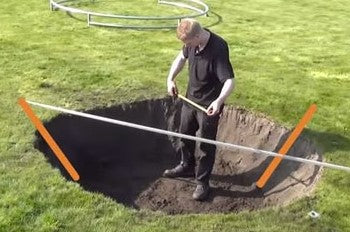Getting a trampoline for your home requires many considerations, but it often comes down to whether or not it's safer to get one type or another. On some level, in-ground trampolines are considered safer because of their proximity to the ground, amongst other things, but both trampolines have similar risk factors.
In this article, we'll help you flesh out the differences between in-ground and above-ground trampolines, look at the pros and cons of an in-ground trampoline and even give you a few installation tips.
In-ground Trampolines Vs Above-ground Trampolines
Safety
Both in-ground and above-ground trampolines have some safety risks. In both mechanisms, jumpers can fall to the ground from the trampoline and hurt themselves. The risk is more significant in an above-ground trampoline as jumper risks fall from much higher and sustain more significant injuries. That's why we recommend safety nets to help protect children and adults from falling off of an above ground trampoline.
With above-ground trampolines, strong winds may blow your trampoline away or flip it, which can cause property damage (unless you devise an anchorage plan). In-ground trampolines, on the other hand, will stay put because of how they're installed.
There’s also the issue of your child's comfort level with trampolines. In that case, smaller children tend to feel safer on an in-ground trampoline as they don't have to worry about climbing stairs to get in, and they're not bouncing several feet above the ground.
Bounce, and Performance
An above-ground trampoline may provide more bounce than an equally configured in-ground trampoline. Jumpers often choose trampolines based on the height they can achieve when using them since that's half of the appeal. However, Avyna's advanced in-ground trampoline engineering design provides equal bounce characteristics equal to its equivalent above ground trampolines.
Installation
It can be more time-consuming and difficult to install an in-ground trampoline than an above-ground one.
Whereas with an above-ground trampoline, you just need a level surface, and to correctly assemble the trampoline's parts, an in-ground trampoline requires several steps. You'll need to dig a hole, pour gravel into that hole, and possibly hire someone to do this.
Cost Difference
From digging equipment to landscaping, the dollars start to add up when installing an in-ground trampoline. It can cost double or triple what you'd spend installing an above-ground trampoline to safely and aesthetically install an in-ground one. Avyna's third-generation in-ground models greatly reduce the costs of an in-ground installation.
In-ground Trampolines Pros And Cons
Pros
● They're great for a cardio workout.
● Your children and often adults will feel safer on them.
● Your pets won't be at risk of getting hurt if they run under one (because they can't get under it).
● They're great for developing fundamental motor skills in both children and adults.
● You get to be more creative with landscaping around them as they can be incorporated into your yard's aesthetic.
Cons
● They cost more to install.
● Without proper drainage, standing water can pose an issue.
● Once installed, they're pretty much stuck in one place unless you want to commit to digging yet another hole in your yard.
● They need proper ventilation to exhaust the air when jumping.
● Older designs require retaining walls, drainage, and foundation setup.
In-ground Trampoline Installation Tips
Get professional help
You're often given a DIY kit to get the job done for in-ground trampolines. Still, we recommend getting certain parts of the installation done by a professional, like the retaining wall (if it isn't included in your model) and setting up your foundation.

Ensure you have enough space around your trampoline hole for safety
Professionals recommend having 3 feet of space around your trampoline hole for safe use. You don't want you or your children bumping into a tree or wall that's too close to the trampoline.
Conclusion
In-ground trampolines are safer to use because of their proximity to the ground when jumping; though the risk of falling is present for both, an injury from a higher level can be more significant. However, it would help if you considered how much more costly it is to install an in-ground trampoline and how important certain steps are during the installation possess. Check out the installation process of Avyna's third generation in-ground models to the older designs of almost all of the other major in-ground trampoline manufacturers.

